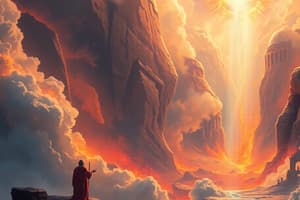Podcast
Questions and Answers
Questions are hidden until you start the quiz
Study Notes
The Word "Apocalypse"
- The word "apocalypse" is derived from the Greek word "apocalypsis," which means "an uncovering" or "revelation."
- It refers to a genre of literature in the ancient world, primarily Jewish, but also Greek, Latin, and Egyptian.
Characteristics of Apocalypses
- Pseudonymous: attributed to some ancient hero or figure
- Set deep in the past, but written at a later time
- Tell the future, often with a chronological span of time
- Feature images, angels, demons, and monstrous beasts
- Constructed as a narrative, often with a storied structure to the universe
- Have a cosmology, with multiple layers of heavens and hells
- Dualistic worldview, with a divide between good and evil, spatially (up there vs. down here) and temporally (before time and after time)
Apocalyptic Worldview
- Influenced by apocalyptic literature, but not necessarily written in an apocalyptic genre
- Features dualisms, such as ethical (good vs. evil), spatial (up there vs. down here), and temporal (before time and after time)
- Expectation of a future kingdom of God, with a catastrophic event preceding it
- Often serves as a form of cultural resistance, particularly among oppressed minorities
The Book of Revelation
- Not pseudonymous, attributed to John the Seer or John the Prophet
- Written in a poor style of Greek, potentially intentionally
- Structured as a series of cycles or spirals, with a catastrophic event building towards the end
- Features letters to seven churches in Asia Minor, the throne room scene, and a series of vivid images and events
- Often interpreted historically, but also has allegorical and theological interpretations
Structure of Revelation
- Chapters 6-8 feature a series of scenes, each with a distinct crisis and quasi-resolution
- The seals on the scroll are broken, releasing horses and riders, representing conquest, warfare, famine, and death
- The fifth seal is a digression, featuring the souls of martyrs under the altar, crying out for justice
- The structure of Revelation is often seen as a spiral, with cycles of crisis and resolution building towards the end### The Book of Revelation Structure
- The Book of Revelation is structured in three cycles of catastrophes, each followed by a digression and a relief
- The first cycle consists of four seals, the fifth seal being a digression, and the sixth seal being a catastrophe
- The seventh seal is an anticlimax, resulting in silence in heaven for a half an hour
The Seventh Seal
- The seventh seal is not what the reader expects after the buildup of tension and catastrophes in the previous seals
- Instead, it results in silence in heaven for a half an hour, which is an anticlimax
- This structure is meant to create a sense of crisis in the reader, followed by a relief
The Purpose of the Book of Revelation
- The purpose of the Book of Revelation is to create a sense of crisis in early followers of Jesus
- The book wants to make Christians uncomfortable with Roman rule and feel a sense of persecution
- The book is meant to be performed, with the reader imagining a world of strange creatures and events
- The book is trying to pull the reader into a world of crisis, but eventually, God will take care of the crisis
The View of Rome in the Book of Revelation
- The view of Rome in the Book of Revelation is negative, with Rome being referred to as "Babylon the Great"
- Rome is described as a dwelling place of demons, with the kings of the earth having committed fornication with her
- The merchants of the earth have grown rich from the power of her luxury
- The number 666 is believed to refer to Nero, the Emperor, and is a symbol of evil
Nero Redivivus
- The myth of Nero redivivus is the idea that Nero, the terrible emperor, will rise from the dead and wage war against the Roman Empire
- This myth was especially chilling for followers of Jesus, as Nero was known for persecuting Christians in Rome
- Nero was blamed for a big fire in Rome, which he allegedly started to clear space for his palace
- He blamed the Christians for the fire and had them crucified and burned in his palace grounds.### The Apocalypse of Revelation
- The apocalypse is a myth where the "whore" (Babylon) is killed, Rome is destroyed, and the wealthy and kings of the earth are destroyed by Jesus and the angels.
- The new Jerusalem is set up, made of gold, with no night or day, and God as its light, where everyone lives happily ever after.
The Letters to the Seven Churches in Revelation
- The letters are written by John, imprisoned on the isle of Patmos, and circulated among the churches.
- The seven churches are in Ephesus and other locations in western Asia Minor.
The Letter to the Church in Ephesus
- The church is praised for their works, toil, and patient endurance.
- The church is scolded for tolerating false apostles and for growing weary.
- The church is told to repent and return to their original works.
The Nicolaitans
- The Nicolaitans are mentioned as a group that is hated by the writer of Revelation.
- There is no clear information about who the Nicolaitans were or what they believed.
The Letter to Other Churches
- The writer praises the church in Smyrna for their poverty and for enduring slander from those who claim to be Jews but are not.
- The writer criticizes the church in Pergamum for accommodating the imperial cult and for eating meat sacrificed to idols.
The Writer's Criticisms
- The writer does not like the wealthy or those who are comfortable with Roman rule.
- The writer does not like idolatry, including the eating of meat sacrificed to idols.
- The writer criticizes a prophet named Jezebel in one of the churches.
Theories about the Writer's Intentions
- The writer may be targeting Paul's churches, which were considered comfortable with Roman rule.
- The writer may be trying to make the churches uncomfortable with Roman rule and turn them against it.
The Word "Apocalypse"
- The word "apocalypse" is derived from the Greek word "apocalypsis," which means "an uncovering" or "revelation."
- It refers to a genre of literature in the ancient world, primarily Jewish, but also Greek, Latin, and Egyptian.
Characteristics of Apocalypses
- Pseudonymous: attributed to some ancient hero or figure
- Set deep in the past, but written at a later time
- Tell the future, often with a chronological span of time
- Feature images, angels, demons, and monstrous beasts
- Constructed as a narrative, often with a storied structure to the universe
- Have a cosmology, with multiple layers of heavens and hells
- Dualistic worldview, with a divide between good and evil, spatially (up there vs. down here) and temporally (before time and after time)
Apocalyptic Worldview
- Influenced by apocalyptic literature, but not necessarily written in an apocalyptic genre
- Features dualisms, such as ethical (good vs. evil), spatial (up there vs. down here), and temporal (before time and after time)
- Expectation of a future kingdom of God, with a catastrophic event preceding it
- Often serves as a form of cultural resistance, particularly among oppressed minorities
The Book of Revelation
- Not pseudonymous, attributed to John the Seer or John the Prophet
- Written in a poor style of Greek, potentially intentionally
- Structured as a series of cycles or spirals, with a catastrophic event building towards the end
- Features letters to seven churches in Asia Minor, the throne room scene, and a series of vivid images and events
- Often interpreted historically, but also has allegorical and theological interpretations
Structure of Revelation
- Chapters 6-8 feature a series of scenes, each with a distinct crisis and quasi-resolution
- The seals on the scroll are broken, releasing horses and riders, representing conquest, warfare, famine, and death
- The fifth seal is a digression, featuring the souls of martyrs under the altar, crying out for justice
- The structure of Revelation is often seen as a spiral, with cycles of crisis and resolution building towards the end### The Book of Revelation Structure
- The Book of Revelation is structured in three cycles of catastrophes, each followed by a digression and a relief
- The first cycle consists of four seals, the fifth seal being a digression, and the sixth seal being a catastrophe
- The seventh seal is an anticlimax, resulting in silence in heaven for a half an hour
The Seventh Seal
- The seventh seal is not what the reader expects after the buildup of tension and catastrophes in the previous seals
- Instead, it results in silence in heaven for a half an hour, which is an anticlimax
- This structure is meant to create a sense of crisis in the reader, followed by a relief
The Purpose of the Book of Revelation
- The purpose of the Book of Revelation is to create a sense of crisis in early followers of Jesus
- The book wants to make Christians uncomfortable with Roman rule and feel a sense of persecution
- The book is meant to be performed, with the reader imagining a world of strange creatures and events
- The book is trying to pull the reader into a world of crisis, but eventually, God will take care of the crisis
The View of Rome in the Book of Revelation
- The view of Rome in the Book of Revelation is negative, with Rome being referred to as "Babylon the Great"
- Rome is described as a dwelling place of demons, with the kings of the earth having committed fornication with her
- The merchants of the earth have grown rich from the power of her luxury
- The number 666 is believed to refer to Nero, the Emperor, and is a symbol of evil
Nero Redivivus
- The myth of Nero redivivus is the idea that Nero, the terrible emperor, will rise from the dead and wage war against the Roman Empire
- This myth was especially chilling for followers of Jesus, as Nero was known for persecuting Christians in Rome
- Nero was blamed for a big fire in Rome, which he allegedly started to clear space for his palace
- He blamed the Christians for the fire and had them crucified and burned in his palace grounds.### The Apocalypse of Revelation
- The writer describes a myth where Babylon, Rome, and wealthy people are destroyed, and a new Jerusalem is established with God as its light.
The Letters to the Seven Churches
- The writer, John, was imprisoned on the isle of Patmos in the Mediterranean when he wrote the letters.
- The letters are addressed to seven churches, including Ephesus, where Paul had founded a church.
- The writer praises some churches and scolds others, criticizing false apostles and idolatry.
The Letter to Ephesus
- The writer commends the church for its patient endurance, testing of false apostles, and hatred of the Nicolaitans' works.
- However, the church is scolded for backsliding and told to repent and return to its original works.
The Letter to Smyrna
- The writer praises the church for its poverty, affliction, and slander, despite claims of being rich.
- The church is commended for not denying its faith in the face of persecution.
The Letter to Pergamum
- The writer acknowledges the church's affliction and living in the midst of the imperial cult.
- The church is praised for holding fast to its name and faith, but criticized for tolerating idolatry.
Criticisms of the Churches
- The writer disapproves of rich people, idolatry, and a woman named Jezebel who is a prophet in one of the churches.
- He criticizes Christians who eat meat sacrificed to idols, considering it idolatry.
- The writer's letters may be targeted at Paul's churches, which are seen as too comfortable with Roman rule.
Studying That Suits You
Use AI to generate personalized quizzes and flashcards to suit your learning preferences.




